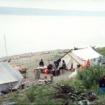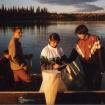Plantain
As medicine
The leaves of the plantain plant are made into a poultice as a painkiller for cuts and bruises and the above ground part of the plant is made into a tea to soothe burns. A leaf that is large enough to cover a cut is used. Fresh leaves are preferred because Ruth said,
When you dry them in the winter, they will [turn to] powder. But you can also make a poultice out of that and do the same thing.
Ruth added,



